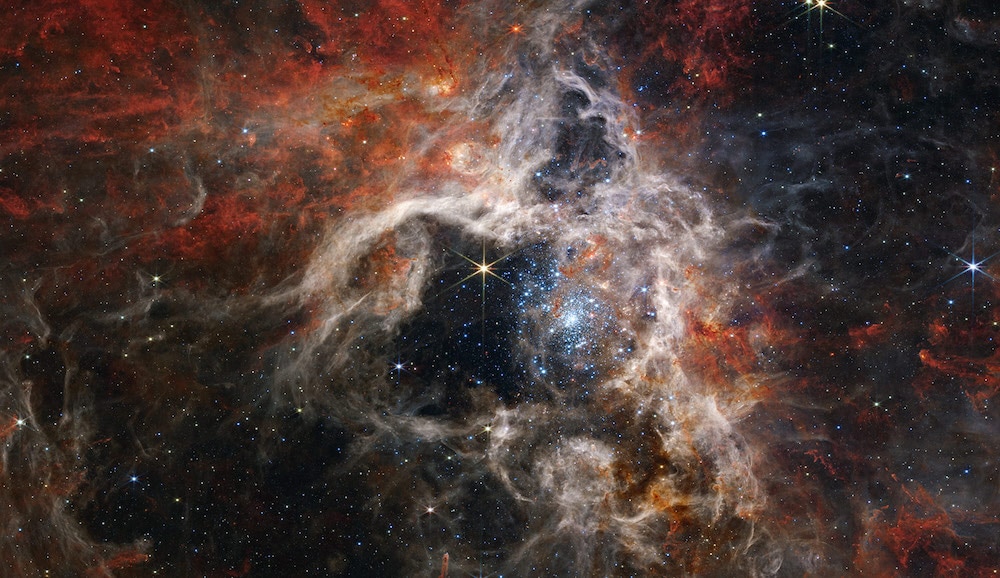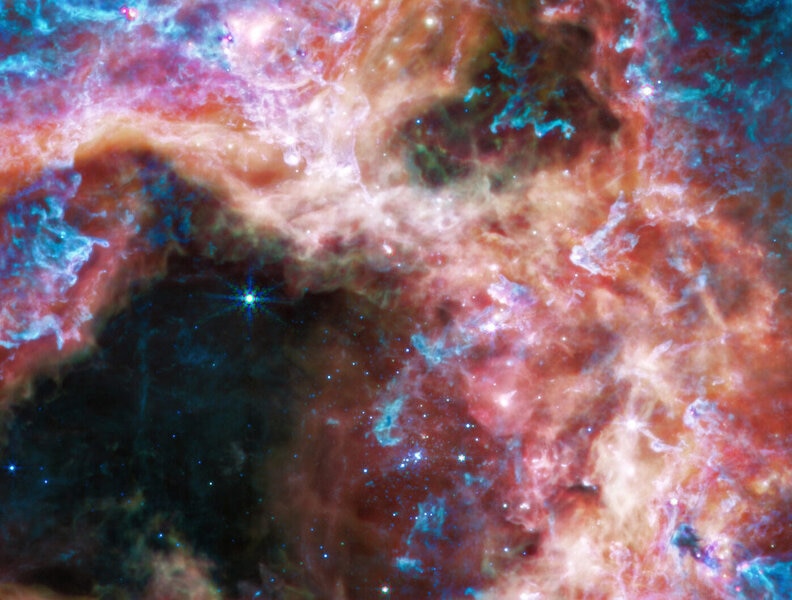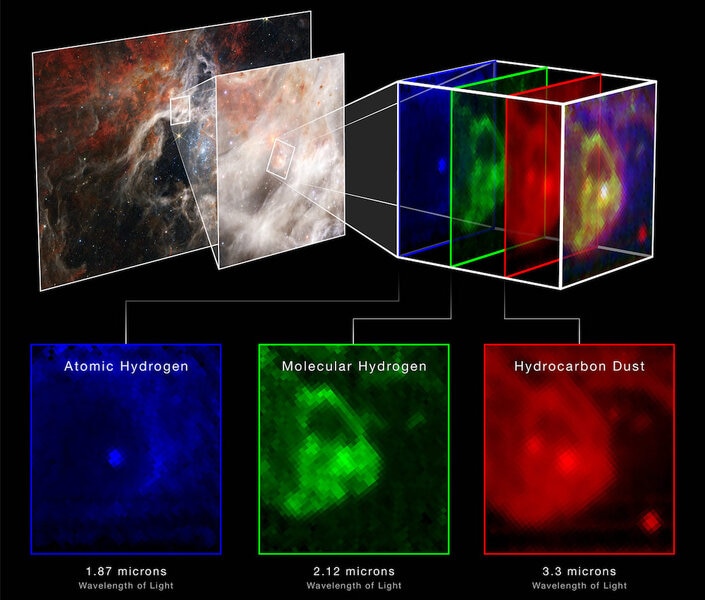Create a free profile to get unlimited access to exclusive videos, sweepstakes, and more!
The infrared heart of the Tarantula
New jaw-dropping JWST images of a vast star-forming factory.

New JWST images just dropped, and seriously, these may be the most beautiful we’ve seen yet.
No surprise it’s so gorgeous when it’s of the Tarantula Nebula, one of the most extreme star-forming gas clouds within a few million light-years of us. It’s in the Large Magellanic Cloud, a satellite galaxy of our Milky Way, and is about 160,000 light-years away. It’s immense, hundreds of light years across, dwarfing by far the Orion Nebula. While most nearby nebulae are forming dozens or hundreds of stars, the Tarantula is actively birthing perhaps millions of stars all at once.
There’s a newly born star cluster in its center called NGC 2070 that has hundreds of thousands of stars in it, so huge that it may actually qualify to be a globular cluster.
Ground-based images of the Tarantula are jaw-dropping, with details visible despite being well outside our own galaxy. But the new JWST images are something entirely else.
[Note: Very high-res versions of all these images are available at the ESA JWST site, and oh my do you want them.]
That is the view from the NIRCam, the Near-InfraRed Camera, which is sensitive to light well outside what our eyes can see. What’s shown as blue is the shortest wavelength of light and it’s still 0.9 microns, just a bit longer than what we can see. What’s displayed as green is actually at 2.1 microns, red is 4.2 microns, and orange 4.7.
This is fundamentally different than what we see in visible light from, say, Hubble or many ground-based observatories. In visible light, the images show warm hydrogen and other elements glowing brightly, while grains of rocky or sooty dust — formed when stars die — are opaque, and show up as dark, hiding stars behind them.
But in the infrared dust glows. Much of what you see in the JWST image is warm dust, heated by the powerful radiation of hundreds of massive stars in the NGC 2070 cluster. In fact, the most massive star known, called R136a1, sits in the center of the cluster, and may have a staggering 200 times the Sun’s mass.
Stars that energetic blast out ultraviolet light that eats away at the gas and dust around them in a process called photodissociation. This carves a huge cavity in the nebula around the cluster, which you can see in the NIRCam image.
The other JWST workhorse camera is MIRI, the Mid-InfraRed Instrument. It sees light with even longer wavelengths than NIRCam. It’s ability to resolve smaller details is not as good, because that depends on the wavelength of light seen, but it still delivers the highest-resolution images ever at those infrared colors. Looking at the center of the nebula it saw this:
Woof. Spectacular. You can see that same bright star as in the NIRCam image, but the cluster is almost entirely invisible! The bright stars there aren’t nearly as luminous in the mid-infrared, while the dust and other features are far more brilliant.
I mentioned sooty dust above; that’s actually made of long carbon-based molecules called polycyclic aromatic hydrocarbons, or PAHs. These are made by carbon-rich red giant and red supergiant stars, huge dying stars that have swollen up to be many tens or even hundreds of millions of kilometers across. The molecules are blown out into space, and can collect in long streamers and walls. These glow at different wavelengths, shown in the MIRI image as blue and red-purple.
These stars also have a lot of silicon, and make tiny rocky grains of silicates, which we also call dust. Those glow at 10 and 18 microns, and are displayed as teal and red.
Some extremely cool stars can still be seen in the image, probably red giants and supergiants nearing the ends of their lives.
But there’s more. The Near-InfraRed Spectrograph, or NIRSpec, breaks the infrared light from an object into individual colors to even better understand the composition of astronomical objects. In a small area near the nebula center, NIRSpec saw evidence of warm atomic hydrogen, shown in blue, much cooler molecular hydrogen shown as green, and more PAHs in red.
The physical situation can be determined by comparing the different colors. A star is being born, embedded in a dense clot of gas and dust. While the atomic hydrogen shows a bubble around it, the molecular hydrogen and PAHs appear to be filling the bubble. If the star were actively eating away at the surrounding material they’d all show a cavity, so it’s likely this star is just starting to switch on, a newborn even among infants.
A lot of infants; the Tarantula is home to another, older cluster of stars called Hodge 301, over a hundred light-years from NGC 2070, but still inside the nebula. And the word “old” is relative; it’s still only a couple of dozen million years old. The Sun is 4.6 billion years old, for comparison.
And stars are forming everywhere in the nebula; on the outskirts, well away from this JWST image, a massive star called Sanduleak -69 202 was old enough to explode as a supernova, called SN 1987A. It was the brightest such supernova in four centuries, and was extremely well studied. JWST has already taken some observations of the material around this event, including the rapidly expanding material from the explosion itself. I studied SN 1987A for many years, and I’m very anxious to see what JWST observed.
Soon. The observatory is keeping astronomers very busy, and there will be many, many more treasures and delights to share over the next few months.





























